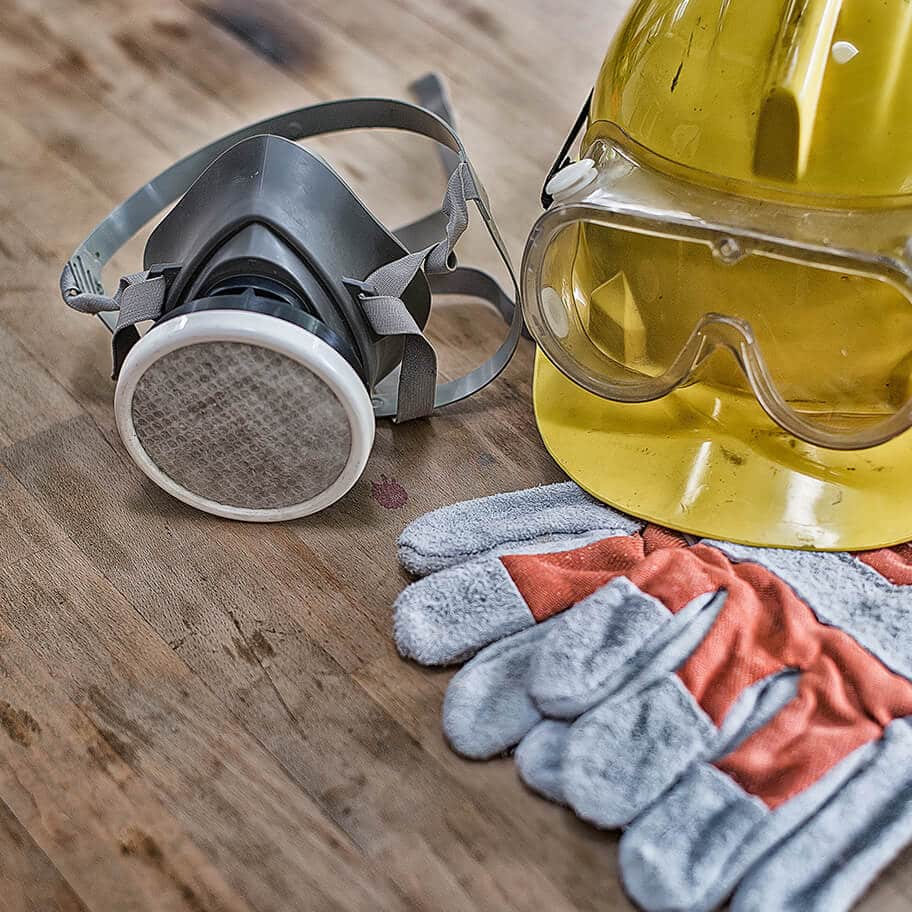Health and Safety Breach
Any instance where an employer has ignored the supply of PPE to save money is considered a health and safety breach and this is where PPE claims arise. PPE claims may also arise in cases where an employer provides faulty or inadequate PPE to their employees which causes an injury at work.
Common Injuries
Some of the common injuries sustained from Personal Protective Equipment (PPE) claims include:
Types of PPE
PPE can include a variety of different safety gear for different jobs and can include the following:
High Visibility Clothing
Such as Hi Vis jackets for those working at night/dimly lit workplaces.
Safety Goggles
These are used in many jobs, for example, a welder must use these to protect their eyes from sparks while welding. A construction worker may use these while carrying out their duties to protect from dust or debris while on a building site.
Hard Hat
This is used to protect a person’s head from falling objects or to protect them if they fall themselves. This is commonly used on a construction site, not only for workers but also for other visitors to the site.
Earmuffs
For those who are exposed to loud noises or working in loud environments.
Gloves
Safety gloves protect the hands and wrists from injuries such as cuts or burns while working with sharp objects to lifting heavy objects.
Safety Harness
This should be provided in cases where you are lifted off the ground while working.
Steel Toe Cap Boots
For a construction site steel toe cap boots are a must to protect your feet from falling objects.
Protective Masks
These face masks prevent a worker from inhaling potentially dangerous particles, e.g. dust particles/fumes.
Flame Resistant Clothing
Such as flame resistant overalls for firefighters
When is PPE Considered Inadequate?
PPE provided by the employer must meet a certain standard, but it is also up to the employee to take care of the PPE, store it correctly and also let the employer or manager know when the equipment is inadequate or needs replacing.
Inadequate PPE could resemble one of the following, for example:
- Eye goggles that don’t fit well and slip off during work.
- Safety boots that are not the correct size or not appropriate for the work environment – for example on a construction site steel toe cap boots are a must.
- Hard hats that don’t fit correctly, that slip down off your head or obstruct your vision by slipping down over your eyes or that are not thick enough to protect you from falling objects.
- Gloves that don’t fit well and are too short or are not thick enough to protect you against the dangers of your job.
- Firefighters that are wearing below standard flame-resistant overalls.
- Protective masks that have holes in them.
Employer Responsibilities
Section 8 of the Safety Health and Welfare at Work Act 2005 puts the duty of care on employers and states that they should supply PPE to employees in areas where the risk of injury may not be adequately controlled. It also states that the employer should:
- Ensure that all PPE is maintained in good working order, inadequate hygienic conditions and that adequate storage is available for the PPE and that necessary repairs, maintenance or replacements are carried out as needed.
- Ensure that PPE is adequate for the purpose of the job at hand.
- Review periodically the use of PPE and make amendments where needed.
- Ensure that PPE is used only for its intended purpose and for no other reason (except in specific or exceptional circumstances).
- Ensure that if an employee must wear more than one item of PPE that both items are compatible with each other.
- Ensure that where it is necessary for an item of PPE is to be worn by more than one person that it doesn’t create any health or hygiene issues.
- Inform the employee of risks that the PPE protects them from.
- Provide the employee with instruction on how to use the PPE.
- Arrange for training and where necessary provide demonstrations of its use.
Employee Responsibilities
Where an employer has adequately trained an employee on how to use PPE the employee must:
- Participate in training
- Follow the training given to them
- Only use the PPE for its intended use
- Take all reasonable steps to ensure that the PPE is returned to storage after they have used it.
- Report any damages or defects to your employer
What to do after an accident at work*?
Following an accident at work, there are a number of steps you should follow:
-
Seek medical attention
Your health is your wealth and should be your first priority. Immediately after an accident at work, take a second to assess yourself to determine if you have any injuries and seek the relevant medical attention. If you have sustained a serious injury ensure that you contact an ambulance to attend the scene.
For minor injuries, you must remember that minor injuries where you ‘feel fine’ could progress to more serious injuries in the future. In this case it is always better to be safe than sorry and advisable that you go to your nearest accident and emergency (A&E) or local GP to be checked out.
-
Report the accident
It is critical to report the accident to your superior, i.e. a supervisor or manager on site. It doesn’t matter how small you think the accident may be. By law, accidents at work are required to be reported if the person is injured and can’t perform their daily work tasks for more than three days. Make sure to fill out an Accident Report Form. This can be used for reference in any medical examination and will also prevent any similar accidents from happening in the future.
-
Identify any witnesses
If possible, try to collect the contact details of anybody that witnessed your accident. This may be of use if you do decide to pursue a workplace accident claim. It is also useful to find out if there is any CCTV in the area where your accident happened.
-
Document the incident
It is important that you collect all the relevant information in connection with your accident:
- How the accident happened
- Details of any witnesses
- If there are any CCTV recordings of your accident
- Take pictures of where the accident happened and what caused your accident
-
Speak to a workplace accident solicitor
If you are considering moving forward with a workplace accident claim for any personal injuries sustained, it is advisable that you speak with a workplace accident claims solicitor as soon as possible. If you are proceeding with a claim, the first step will be submitting your claim to the Personal Injuries Assessment Board (PIAB) for assessment. A workplace accident solicitor can help you in preparing your application to the Personal Injuries Assessment Board (PIAB) and ensure that you follow the process in the correct format, meaning that you can move forward with your claim quickly without unnecessary delays.
It is important to remember to keep copies of any expenses that you have incurred as a result of the accident. It is also imperative to retain copies of medical reports or incident report forms where possible as you will need them when making a claim.

